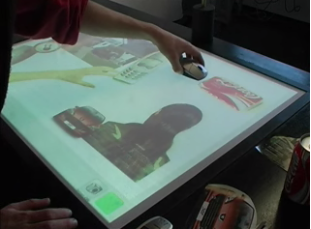I’ve posted about novel ways to interact with our computers a couple of times before. I know this is a bit off-topic, but, to me at least, programming is also about transforming computers into something useful, and thinking about new ways to interact with them is an excellent way to pursue that goal. After all, all-time favorite languages of mine like Lisp or Smalltalk were born while people were struggling with making computers useful and/or accessible.
I’ve always loved the stories about how our current interaction paradigm was invented by Alan Kay and friends over at Xerox Parc, as recounted in books like Dealers of Lightning or the excellent Tools for Thought; or in papers like Alan Kay’s classic on the history of Smalltalk. The people exploring new ways to interact with computers look to me as the heirs of this tradition. I find also pretty interesting to try and imagine how on earth they’re implementing this new stuff, and would love to hear about the languages and environments they use.
Admittedly, the tricks i’m about to show you have, at first sight, no direct application to our work as programmers, but hey, you know what Hertz thought of his experiments on electromagnetic waves, don’t you?
Yeah, right, i’d better stop talking and show you the cool stuff. The first video (hat tip the Cynical-C Blog) makes true the dream of any physics teacher:
This beauty comes from MIT, but there are already commercial versions (including a free lite version) available from Pintar Media.
I found the second video i want to show you while reading about a ‘Minority Report’ interface created for US military (interesting on its own, by the way). It shows another ‘analogue’ input device called Blue Eye, a kind of universal photocopier (and part of the Visual Interaction Platform):
OK. Probably more useful to designers than to programmers, but funny anyway, and perhaps a glimpse of the kind of devices we’ll be programming in the not so far future. A challenging prospect, don’t you think so?






October 30, 2006 at 6:26 pm
A colleague sent me this link today, thought you might like it. A cool multi-touch display/interaction shown at the TED conference:
http://ted.com/tedtalks/tedtalksplayer.cfm?key=j_han&flashEnabled=1
November 25, 2006 at 10:33 pm
That first one, the company I interned for in 2005 made some software that does that. Leszynski. For reference, anyone who owns a Tablet PC can grab a copy from Microsoft, it is one of their freebies for Tablet PC owners. The original MIT project is here and Physics Illustrator (the Tablet PC version) is here.
It is pretty cool, but a bit buggy unless you have a huge digital white board that like professor has!